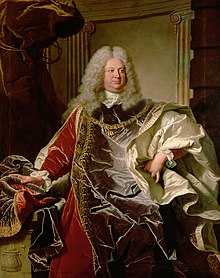Philipp Ludwig Wenzel von Sinzendorf

Philipp Ludwig Wenzel von Sinzendorf (26 December 1671 – 8 February 1742) was an
Origin
He was born in the Austrian capital Vienna, into the prominent House of Sinzendorf, as the son of Count Georg Ludwig von Sinzendorf (1616–1681), and his wife, Duchess Dorothea Elisabeth of Schleswig-Holstein-Sonderburg-Wiesenburg (1645–1725). His father served as president of the Habsburg court chamber under Emperor Leopold I. After the emperor led a thorough examination of his financial irregularities, Georg Ludwig was sentenced to life imprisonment, but his wife managed the commutation of the sentence into house arrest in one of the palaces of the family. As a younger son of this marriage, Philipp Ludwig was designated early for an ecclesiastical career and joined the cathedral chapter in Cologne.
Rise
After his brother's death in the
In 1699, hardly a 28-year-old, he was appointed
Court Chancellor
After the death of Emperor Leopold, Sinzendorf gained the favor of Emperor Joseph I, who made him in 1705 Court Chancellor (Obersthofkanzler). He was also the protector of the Imperial Academy of Arts. He was a central figure for four decades, especially in the foreign policy of the Habsburg Empire. In 1706 he negotiated in The Hague with John Churchill, 1st Duke of Marlborough and the Netherlands' representatives. He was next to Eugene of Savoy in 1709 and negotiator in the negotiations to a preliminary peace that failed, because of the excessive demands from the side of Sinzendorf. In this way he succeeded in preventing a premature Austrian demand for peace.
The Emperor rewarded Sinzendorf for his services by awarding him the fiefs of Hals and Schärding in Bavaria. Surprised by the death of the Emperor in The Hague, he went immediately to Frankfurt am Main to lobby for the election of Charles VI as Holy Roman Emperor. After the election, Charles VI confirmed Sinzendorf in his offices and while he accompanied Charles to his coronation in Frankfurt, Charles VI appointed him
In negotiating the
After the emperor's death, he supported
See also
Notes and references
![]() Media related to Philipp Ludwig Wenzel von Sinzendorf at Wikimedia Commons
Media related to Philipp Ludwig Wenzel von Sinzendorf at Wikimedia Commons
